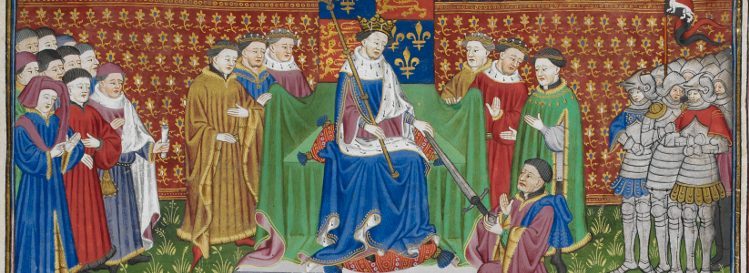The Treaty of Troyes recognised the victorious Henry the Fifth as heir to the French throne, and on 2 June 1420 he married the daughter of Charles VI, Princess Catherine of Valois. King Henry brought his bride back to England, landing on 1 February 1421. Catherine was crowned queen in Westminster Abbey on 23rd of the same month. There was little time for wedded bliss, as Henry crossed back over to France in June with a small force of 900 men-at-arms and 3,300 feared English archers as reinforcements. He left his queen behind in the security of her new, but to her strange, kingdom. As Henry departed, he was certainly aware that his wife was pregnant, which was doubtless why she remained in England. Not only were there the dangers to her pregnancy to be considered, but it was also appropriate for any heir to the throne to be born in England itself.
With the approach of her confinement five months later, preparations were taken in hand pending the royal birth. These included sending for the so-called silver jewel from the Benedictine abbey of Coulombes in France, which reputedly contained the foreskin from the circumcision of the Infant Jesus and was believed to ease women through their labour. Whatever its efficacy, the queen appears to have experienced a trouble free pregnancy and birth.
Queen Catherine was safely delivered of a healthy baby prince in Windsor Castle at 4 p.m. on Saturday, the feast of St. Nicholas, 6 December 1421. The baby boy was named Henry after his father and grandfather before him. As preparations for his baptism were begun, the news was sped across the channel, where French churches added their joyful chimes to those of the English bells ringing out a welcome to the newly born heir to the two kingdoms and the promise of a new era of peace and harmony. King Henry in France, who was currently besieging the town of Meaux , had little time to rejoice, but he did send a delighted message back to Queen Catherine instructing that a votive Mass of the Holy Trinity be celebrated in thanksgiving for the prince's birth. He then returned to the grim business of trying to secure his new son's French inheritance.
While messengers carried the glad tiding throughout the realm, the baptism was taking place at Windsor. Prince Henry was borne to the font by his two godfathers, his great-uncle Henry Beaufort, Bishop of Winchester, and his uncle, the king's brother, John, Duke of Bedford. His godmother was Jacqueline of Holland, the estranged wife of the duke of Brabant and a refugee at the English court. She had quickly become a close friend to the lonely Queen Catherine. The archbishop of Canterbury, Henry Chichele, performed the christening itself. There followed straight away the administration of Confirmation, as was quite customary in the Middle Ages. This time Archbishop Chichele stood sponsor, while we may assume that Bishop Henry Beaufort administered the sacrament.
Privy seal summonses were sent out to those expected to attend the "solemnization of the purification of Catherine, Queen of England" to be held at Windsor on 12 January 1422. The queen herself intended to depart soon after her "churching" to rejoin her husband in France, and ships and their crews were held in readiness for her crossing at Southampton, Melcombe and other ports. It was not until 12 May, however, that Queen Catherine finally embarked at Southampton with her brother-in-law John, Duke of Bedford. The delay had been caused by the need to await the arrival of the king's youngest brother Humphrey, Duke of Gloucester, returning from the French wars to replace Bedford back in England. The baby Prince Henry was left at Windsor in the care of his nurses, Elizabeth Ryman and perhaps Joan Asteley and Mathilda Fossebrok (Fosbroke).
